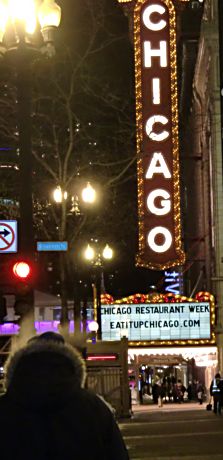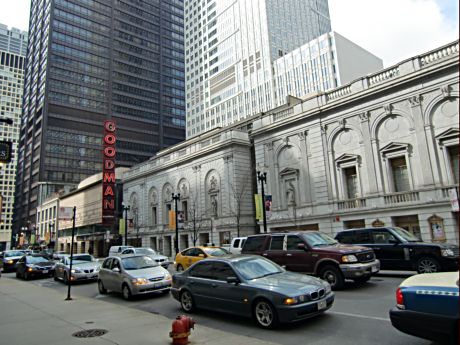Chicago doesn’t promote that it is a great theater town with about 200 stage companies in its metropolitan area. But if you are merely in and out of the city for a quick visit, try to get tickets to a show downtown. At the least, you will see a grand, historic venue.
However, production companies know that Chicago audiences are sophisticated theater-goers with high expectations so you are likely to see an exceptional performance.
Don’t worry if you don’t have time to go to several shows. You can admire their venue’s architecture and, in some cases, over-the-top décor. Many Chicago’s stages are in glorious marble, gold, exotic “palaces.”
Theater venues is the fourth category in the downtown Chicago walks series that includes, art, architecture, restaurants and shopping. Some theaters conduct tours but even if a theater is closed, box offices are often open so at least you can peak into some lobbies.
Combine any of the following five theaters with restaurant suggestions or the art and architecture walks.

If in the south end of the Loop for art or architecture definitely stop by the Auditorium Theatre at 50 E. Congress Parkway, Chicago, IL 60605 adjacent to Michigan Avenue. Extending around the corner onto Michigan Avenue, the building has been home to Roosevelt University for more than half a century.
Listed on the National Register of Historic Places and designated a National Historic Landmark, the building was designed by Dankmar Adler and Louis Sullivan. When completed in 1889, it was the city’s tallest building. Notice its arches. They are Sullivan hallmarks.
Try to schedule a tour ahead of time. Built as an opera house, its auditorium is gorgeous. Home to the Chicago Symphony Orchestra from the late 1800s to the early 1900s, it has wonderful acoustics.
When walking in the central Loop area west of the Art Institute of Chicago, peer into the Bank of America Theatre in the Majestic Building.
Sitting just west of State Street at 18 W. Monroe St., Chicago, IL 60603, the building and its playhouse, the Majestic Theatre, date to 1906. A vaudeville playhouse, the theatre featured such entertainers as Harry Houdini, Al Jolson and Fanny Brice.
Closed during the Great Depression, it reopened in 1945 as the Sam Shubert Theatre. It was the place to go to see such post war musicals as “South Pacific” and “Guys and Dolls.” Later, it was the LaSalle Bank Theatre. Bank of America acquired the LaSalle and renamed the venue in 2008. The theatre is popular for pre-Broadway premieres from The Good-by Girl in 1993 to “Kinky Boots” in 2012 and hosts Broadway in Chicago productions.
To do a theater walk, start at the Cadillac Palace, 151 W. Randolph St., Chicago. 60601.
Inside, large mirrors, crystal chandeliers and violet and white marble will have you believing you have moved through space to the palaces of France.
Built during the extravagant mid-1920s, the Palace Theatre (later the Cadillac Palace) was an Orpheum Circuit vaudeville playhouse. During its many lives, the venue was a movie house, banquet hall, rock venue and playhouse called the Bismark Theatre.
Renovated in 1999, it became the Cadillac Palace, hosting pre-Broadway openings of “The Producers and “Mamma Mia” and also other hit shows.
Walk east on Randolph past the impressive glass James Thompson Center, then north a block to the internationally renowned Goodman Theatre at 170 N. Dearborn St., Chicago, IL 60601.

Housed in a north wing of the Art Institute of Chicago built for the Goodman in the 1920s and opened in 1925, the theatre moved to its Dearborn location in 2000. It is on the former site and incorporates the former landmark facades of the Selwyn and Harris Theaters.
Totally unlike the ornate 1920s theater palaces, its main stage, the Albert Ivar Goodman Theatre, is a comfortable, casual space with side balconies somewhat old-world reminiscent of the Globe Theatre.
Artistic Director Robert Falls has staged and overseen several world premieres and notable productions. Among them is “The Iceman Cometh” starring Brian Dennehy. The Goodman’s annual presentation of Charles Dickens’ “A Christmas Carol,” has become a Chicago area family tradition.
Return to Randolph Street, to walk east to the Oriental Theatre, 24 W Randolph St., Chicago, IL 60601.
This is the site of the Iroquois Theater, whose deadly 1903 fire led to improved theater safety standards across the country. Designed by George and Cornelius Rapp and opened by Balaban and Katz as a movie palace in 1926, the theater’s Far East carvings, color and decor has visitors oohing and aahing before the show starts.
Closed due to disrepair in 1981, the theater underwent restoration and was renamed the Ford Center for the Performing Arts in 1997. It reopened in 1998 with the premiere of “Ragtime.”
The Oriental is just west of State Street so make the last stop the Chicago Theatre, 175 N. State St. Chicago, IL 60601.
Built in 1921 for $4 million, it is arguably the Balaban and Katz venue that made the statement: movie theater lobbies and auditoriums should look like palaces. The Rapps designed this theater in French Baroque style. Make a reservation for a tour to stand on the stage and go back stage.
Great entertainers have performed on Chicago’s downtown stages. World premieres and memorable performances have taken place there. So be sure to put Chicago theaters on the to-do list.
